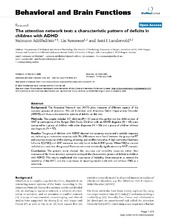| dc.contributor.author | Adólfsdóttir, Steinunn | |
| dc.contributor.author | Sørensen, Lin | |
| dc.contributor.author | Lundervold, Astri Johansen | |
| dc.date.accessioned | 2008-06-09T08:33:26Z | |
| dc.date.available | 2008-06-09T08:33:26Z | |
| dc.date.issued | 2008-02-12 | eng |
| dc.Published | Behavioral and Brain Functions 2008, 4:9 | en |
| dc.identifier.issn | 1744-9081 | |
| dc.identifier.uri | https://hdl.handle.net/1956/2705 | |
| dc.description.abstract | Background: The Attention Network test (ANT) gives measures of different aspects of the complex process of attention. We ask if children with Attention Deficit Hyperactivity Disorder (ADHD) will show a characteristic pattern of deficits on this test. Methods: The sample included 157 children (M = 10 years) who performed the child version of ANT as participants of the Bergen Child Study. Children with an ADHD diagnosis (N = 45) were compared to a group of children with other diagnoses (N = 55) and a group of children without any diagnosis (N = 57). Results: The group of children with ADHD showed low accuracy scores and a variable response set, indicating an inattentive response style. No differences were found between the groups on RT and accuracy measures of the alerting, orienting, and conflict networks. A high correlation between full scale IQ (FSIQ) and ANT measures was only found in the ADHD group. When FSIQ score was included as a covariate, the group differences were not statistically significant on any ANT measure. Conclusion: The present study showed that accuracy and variability measures rather than measures of the three attention networks conveyed the characteristic pattern of deficits in children with ADHD. The results emphasized the importance of including these measures to extend the sensitivity of the ANT, and the importance of reporting results both with and without FSIQ as a covariate. | en_US |
| dc.language.iso | eng | eng |
| dc.publisher | BioMed Central | eng |
| dc.title | The attention network test: a characteristic pattern of deficits in children with ADHD | eng |
| dc.type | Peer reviewed | |
| dc.type | Journal article | |
| dc.identifier.doi | https://doi.org/10.1186/1744-9081-4-9 | |
| dc.identifier.cristin | 364664 | |
| dc.subject.nsi | VDP::Samfunnsvitenskap: 200::Psykologi: 260::Kognitiv psykologi: 267 | nob |
